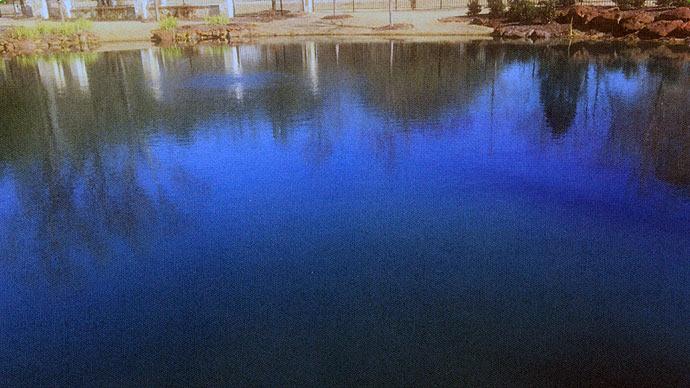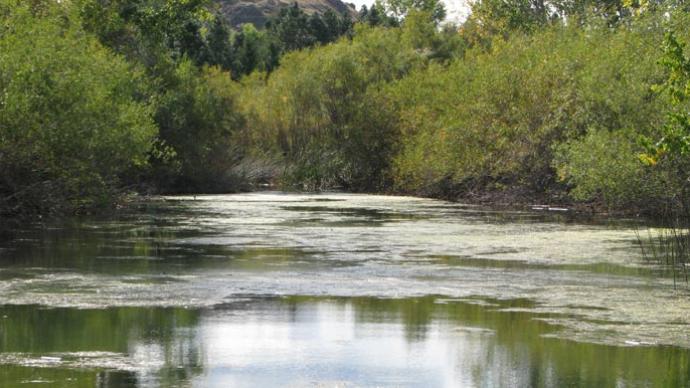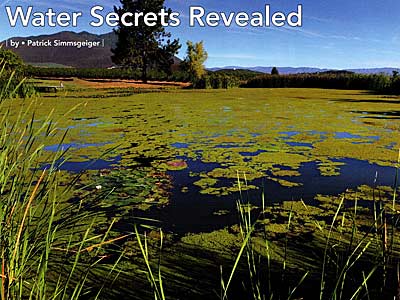
Almost every day I am asked to outline a pond water treatment plan from our home base here in California. New clients and old friends expect answers to be simple, but there are many 'It Depends' caveats. Each body of water is unique, responding best to a slightly different approach. Rarely is it simple. We have desert ponds, golf course ponds, farm ponds, and lots of urban ponds. Not only are the ecosystems different, their water sources vary as well. When dealing with water here, we have to understand the mission. Are we dealing with a rooted aquatic plant problem or some mysterious algae issue? Or, does the water have a musty odor? Even if the analysis and prescribed dosage is simple, the application method is as important as the products.
These client conversations often reveal that the owner is unsure of site-specific details, deeper challenges presented, and the nuances of water treatment, much less the consequences of making an insufficient decision. Setting all that aside, the following is a simplified analytical approach to aquatic treatment plans.
The best management practice for water is to use the least amount of chemicals needed to accomplish the goal. In other words, more is not better. This is balanced against the need to control unwanted and invasive species, while minimizing effort. Ecologic diversity is an important long-term goal. Don't kill everything. Below a certain dosage, approved chemicals have a negligible environmental effect. Therefore, with this strategy, an aquatic program generally first increases toxicity, then ramps down chemical usage, based on control. Ultimately, the desired aquatic plant growth becomes acceptable, costs are reduced, and water ambience/function approaches near maximum.
The following factors affect water treatment estimates:
Water Volume: What is the surface area and average depth?
Water Source: Does the lake fill with water from rainfall runoff, an aquifer, a deep well, city water, or reclaimed water? The less pristine the source, the higher the nutrient loading and thus the more product (herbicides, microbes, enzymes) needed for the same level of control. This principle also applies to landscaping and nearby livestock, especially uphill and upwind. Added nutrients alter nature's growth in water.
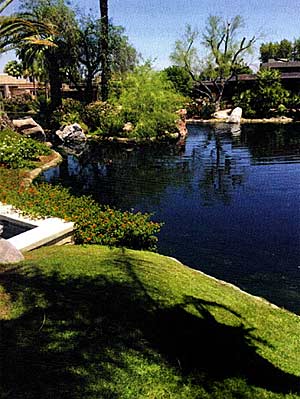
Dissolved Oxygen: Does the water have enough dissolved oxygen (DO) available, both for the fish and other oxygen consuming creatures and bacteria? Generally, 4ppm is poor DO, 6+ppm is good, whereas 3ppm or lower we'll see fish kills. Higher DO will somewhat discourage the growth of algae and cyanobacteria. Lower temperature waters can hold more DO; more salinity can reduce DO; more wind increases surface DO and evaporation. A lake often requires mechanical aeration to have sufficient DO, such as diffusers, fountains, and waterfalls.
Depth Max and Average: Water depth is important to know for application calculations, but also to estimate biological functions. Comparing the current depth profile with the lake's original design, the difference is muck and silt accumulation, which is a combination of dirt/clay and biological material. Bottom diffusers are less effective at DO introduction at depths less than 6 feet; depths greater than 40' see less DO despite the lower temperatures at those depths.
Mixing and Circulation: Moving water is healthy water. How long does it take for the entire volume to recycle? Healthy water turns over a few times a day. Circulation implies mixing, which is enhanced by bottom diffusers at all depths. Large bodies of water often have coves and fingers, which have lower circulation. The larger a lake, the less likely it has good circulation, especially at the deepest points.
Effluent: Where does the water flow when it leaves your lake/property? EPA and some State laws limit pesticides and other products in water. A property owner should not add any product before understanding laws governing their property and property downstream receiving runoff.
Changing the Environment: Peripheral trees and other high nutrient sources may need to be moved or eliminated. They should at least be recognized for their contributions to your pond. Increased sunlight typically results in more algae growth. Increased wind from tree removal will help the DO% but will also increase evaporation. More evaporation will increase the cost of water replacement, so dissolved solids in the water may increase. Some lakes are devoid of aquatic vegetation. Introduction of fast-growing native aquatic plants can consume lots of nutrients. Over time, these plants could take over 50-80% of the lake surface, requiring a huge annual expense to cut back. It's a Catch-22 situation. Before adding or subtracting to an aquascape, including the nearby landscaping, consider the long-term outcomes carefully.
Goals and Limitations: Clearly define what is your highest priority, and which goals may cause you to amend the process. Water management is not intuitive, often having capital and recurring costs. Many companies and manufacturers offer different products and processes, promising similar outcomes. Some prefer eradicating everything for maximum control in the short-term, minimizing labor and short-term cost. Others prefer a more ecologic approach, using subtler products that 'turn the big ship' around slowly, similar to how the problem happened in the first place. One reservoir owner wants maximum volume with a healthy environment and constant treatments just below toxic limits. A mixed-use HOA wants fish and no algae blooms, with butterflies and birds coming back each year. Depending on the property either can be correct.
CALCULATIONS
Step One is usually control of algae/cyanobacteria, which may be at the advanced stage of a Harmful Algae Bloom (H AB). Copper (Cu) products are effective, coming in several forms. Using a double-chelated product, which is a liquid, is efficient. There are other products out there which take a different approach, so be sure to learn all your options before choosing what to use and how to do it.
Example:
Volume of Water 300' x 700' x 11' average depth = 2,310,000 Cubic Ft. It's a closed system with average water source quality and no effluent issues. The surface is 4.82 acres, or 210,000 Ft Sq., so a fairly large lake. Air Temp Day Avg ~ 85 F. Circulation is not good; Wind is high from the west; trees and brush surround the entire lake.
The lake was built in 1975 as a reservoir for cattle and crops, plus flood protection. Original depth was 25'. The bottom layer is 60% mud/40% bio muck, reducing the original volume by about half. The abundance of minerals makes this hard water, known to precipitate copper in lower quality algaecides. The water is highly turbid with planktonic alga, plus a top matting of Lyngbya. There is no aeration.
A new owner has finished building a home on the lake; the big family has moved in; they like fishing and being outdoors with their dogs.
Solution:
The family wants a fast fix, but years of damage and a weak biosphere will take 1-2 years to address, assuming the best approach. Because they just made a big move, funds are tight and big investments for the lake are not in the budget. A middle ground solution is needed now. For safety until the H AB is eliminated, forbid any swimming, and pets should be kept from the water.
Even though people and animals should not be in the water, it is being used to water crops and fill troughs. The cows seem healthy. Sheep are very susceptible to copper, so they should be watered from another source. Now that the family is safer, the application can be considered. Maximum Copper for potable water should be approached, so calculate your application based on the label of the product you choose.
Use the calculations we've outlined in this article.
How to Estimate Lake or Pond Size
Measure Length (L), Width (W), and average Depth (D) in FEET. Then multiply for:
Square shaped bodies of water: L x W x D x 7.5 = Approximate Gallons
Circular or Elliptical bodies of water: L x W x D x 5.9 = Approximate Gallons
- Total gallons divided by 325,851.6 (gallons per acre feet) = Acre Feet
- Total length x width divided by 43,560 sq ft = Surface Acre
Example: 1,000'L x 600'W divided by 43,560 sq ft = 13.8 Surface Acre
Follow label instructions on all products.
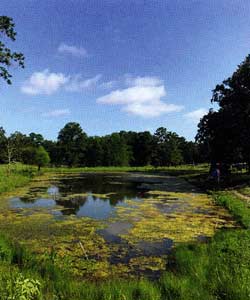
Despite budget issues, the owner in our example above installs one multi-head diffuser in the deepest spot, increasing DO and mixing. The water column is so unhealthy no enzyme will diffuse to the bottom. It will take time for beneficial microbes and enzymes to do what they do, so consider adding healthy products to expedite this process. Multiple advantages are slowly observed as the ecosphere reacts over the first six months.
Next year, as long as flushing is minimal, we'll see that applications are reduced by half, then by half again. Maybe a long-lasting aquatic-blue dye with a U V blocker is added to the process during winter to delay plant or plankton growth the following spring. The family likes the color, but biologically, the reduction of photosynthesis is sought. Then, we might add a clarifier to the treatment, dropping nutrients into remaining muck, which is now being eaten by the expanding colony of beneficial bacteria. The ugly and smelly matting has not returned; fish are abundant and healthier.
Other important applications can be incorporated, like more instruments in a song. Clarifiers bind and drop particles from the water column, so their nutrients are unavailable to algae. A defoamer will break down unsightly bubbles. Two different quality dyes can mix for a preferred look, while not compromising the UV-blocking performance of the blue/yellow product. Pure bacteria and vital minerals replace those missing and absorbed by struggling water.
Finishing our story... More aeration is installed in 2-3 years. At this stage, synthetic chemicals are mostly replaced with biologic products. The family includes a waterfall built with local rocks, which pushes surface currents against the prevailing winds, clearing out the last stagnant region. Only in especially hot years, when pollution overwhelms the balanced and healthy water, does the family resort to a control treatment. But now the lake recovers quickly. Maintenance is sufficient for many years and fish thrive.
Founder and President of Diversified Waterscapes, Patrick Simmsgeiger is a Licensed Aquatic Pesticide Applicator, Landscape Contractor, and Certified Lake Manager.
Reprinted with permission from Pond Boss Magazine

